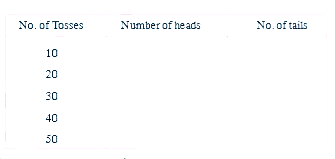If two identical coins are tossed simultaneously. Find (a) the possible outcomes, (b) the number of total outcomes, (c) the probability of getting two heads, (d) probability of getting atleast one head, (e) probability of getting no heads and (f) probability of getting only one head.Solution in Telugu
Step by step video & image solution for If two identical coins are tossed simultaneously. Find (a) the possible outcomes, (b) the number of total outcomes, (c) the probability of getting two heads, (d) probability of getting atleast one head, (e) probability of getting no heads and (f) probability of getting only one head. by Maths experts to help you in doubts & scoring excellent marks in Class 9 exams.
Updated on:21/07/2023Topper's Solved these Questions
- PROBABILITY BOOK - NCERT TELUGUCHAPTER - PROBABILITY EXERCISE - EXERCISE 14.1
21 Videos
- PROBABILITY BOOK - NCERT TELUGUCHAPTER - PROBABILITY EXERCISE - DO THIS
24 Videos
- POLYNOMIALS AND FACTORISATION BOOK - NCERT TELUGUCHAPTER - POLYNOMIALS AND FACTORISATION EXERCISE - TRY THESE
6 Videos
- PROOFS IN MATHEMATICSBOOK - NCERT TELUGUCHAPTER - PROOFS IN MATHEMATICSEXERCISE - EXERCISE - 15.4
9 Videos
Similar Questions
A die has six faces numbered from 1 to 6. It is rolled and the number on the top face is noted. When this is treated as a random trial.
What are the possible outcomes ?
View SolutionToss a coin for number of times as shown in the table. And record your findings in the table.

What happens if you keep on increasing the number of tosses.
View SolutionWrite a polynomial with 2 terms in variable x.
View SolutionState which of the following are mathematical statements and which are not? Give reason.
She has blue rays
View SolutionIf two identical coins are tossed simultaneously. Find (a) the possible outcomes, (b) the number of total outcomes, (c) the probability of getting two heads, (d) probability of getting atleast one head, (e) probability of getting no heads and (f) probability of getting only one head.
View SolutionIf three coins are tossed simultaneously then write their outcomes.
a) All possible outcomes
b) Number of possible outcomes
c) Find the probability of getting at least one head
(getting one or more than one head)
d) Find the Probability of getting at most two heads
(getting Two or less than two heads)
e) Find the Probability of getting no tails
View SolutionIf two identical coins are tossed simultaneously. Find (a) the possible outcomes, (b) the number of total outcomes, (c) the probability of getting two heads, (d) probability of getting atleast one head, (e) probability of getting no heads and (f) probability of getting only one head.
View SolutionIf three coins are tossed simultaneously then write their outcomes. a) All possible outcomes b) Number of possible outcomes c) Find the probability of getting at least one head (getting one or more than one head) d) Find the Probability of getting at most two heads (getting Two or less than two heads) e) Find the Probability of getting no tails
View SolutionIf two identical coins are tossed simultaneously. Find (a) the possible outcomes, (b) the number of total outcomes, (c) the probability of getting two heads, (d) probability of getting atleast one head, (e) probability of getting no heads and (f) probability of getting only one head.
View SolutionIf three coins are tossed simultaneously then write their outcomes.
a) All possible outcomes
b) Number of possible outcomes
c) Find the probability of getting at least one head
(getting one or more than one head)
d) Find the Probability of getting at most two heads
(getting Two or less than two heads)
e) Find the Probability of getting no tails
View SolutionIf two identical coins are tossed simultaneously. Find (a) the possible outcomes, (b) the number of total outcomes, (c) the probability of getting two heads, (d) probability of getting atleast one head, (e) probability of getting no heads and (f) probability of getting only one head.
View SolutionIf two identical coins are tossed simultaneously. Find (a) the possible outcomes, (b) the number of total outcomes, (c) the probability of getting two heads, (d) probability of getting atleast one head, (e) probability of getting no heads and (f) probability of getting only one head.
View SolutionIf three coins are tossed simultaneously then write their outcomes.
a) All possible outcomes
b) Number of possible outcomes
c) Find the probability of getting at least one head
(getting one or more than one head)
d) Find the Probability of getting at most two heads
(getting Two or less than two heads)
e) Find the Probability of getting no tails
View SolutionTwo coins are tossed simultaneously. Find the probability of getting exactly one head.
View SolutionTwo coins are tossed simultaneously. Find the probability of getting exactly one head.
View SolutionIn a simultaneous toss of two coins, find the probability of getting: exactly one head
View Solution
